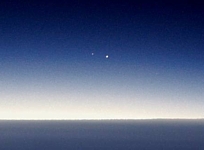8) The Moon describes a transit that places half of its cycle above the Earth's plane with respect to the Sun, and the other half below that plane.
 The Moon, as already mentioned in a previous exercise, transits along the ecliptic line just like the Sun. But it is not subject to an exact line, but rather moves within a range within that band. If one follows the trajectories of the Sun and the Moon extensively in the daytime sky, equipped with some rudimentary device that allows one to compare their positions, one will notice that the Moon passes "above" or "below" the Sun, further back or further ahead, without ever crossing, except on rare occasions; therein lies the maximum expression of this phenomenon, which occurs during a solar eclipse, when the Sun is exactly in conjunction with the Moon, or in a lunar eclipse, when the Moon crosses the shadow cone cast by the Earth. Since these crossings happen only every so often, solar or lunar eclipses do not occur every month. This exercise is the least feasible to verify in its maximum expression (an eclipse) because it can take several months for one to occur, but the lunar deviation in its trajectory can be measured.
The Moon, as already mentioned in a previous exercise, transits along the ecliptic line just like the Sun. But it is not subject to an exact line, but rather moves within a range within that band. If one follows the trajectories of the Sun and the Moon extensively in the daytime sky, equipped with some rudimentary device that allows one to compare their positions, one will notice that the Moon passes "above" or "below" the Sun, further back or further ahead, without ever crossing, except on rare occasions; therein lies the maximum expression of this phenomenon, which occurs during a solar eclipse, when the Sun is exactly in conjunction with the Moon, or in a lunar eclipse, when the Moon crosses the shadow cone cast by the Earth. Since these crossings happen only every so often, solar or lunar eclipses do not occur every month. This exercise is the least feasible to verify in its maximum expression (an eclipse) because it can take several months for one to occur, but the lunar deviation in its trajectory can be measured.
Preliminary conclusion: Deviation of the Moon with respect to the ecliptic line. With these measurements, although they require more reasoning, one can know the "drift" of the Moon in its passage through that "imaginary band" (In practice the lunar orbital plane is inclined 5° with respect to the ecliptic) and how this implies that we do not have a Sun-Moon conjunction, or a passage of the Moon through the Earth's shadow cone, every month (although saying "shadow cone» involves knowing the relative position of the Earth, the Sun and the Moon in space. Using mathematics, it is even possible to predict when the next eclipse will occur, if the trajectory and displacement variables in relation to the ecliptic are known precisely.
9) There are planets like Venus or Mercury that move relative to the "fixed" stars of sunrise/sunset, but always in apparent proximity to the Sun.
 This exercise assumes that the observer, in addition to following the Sun and the Moon during daylight hours, has also paid attention to other objects that are not observed fixed in relation to the "star background." There are 5 planets visible to the naked eye, but at sunrise/sunset the most likely to be seen are Mercury and Venus (which for the purposes of this exercise will only be considered as a "fainter object" and a "brighter object"). To determine that these objects really move independently, a follow-up is needed that can last several months, depending on how long it takes one to notice their own motion, and how long it takes to notice that their appearance is always in temporal proximity to the Sun (the latter can take at least a year).
This exercise assumes that the observer, in addition to following the Sun and the Moon during daylight hours, has also paid attention to other objects that are not observed fixed in relation to the "star background." There are 5 planets visible to the naked eye, but at sunrise/sunset the most likely to be seen are Mercury and Venus (which for the purposes of this exercise will only be considered as a "fainter object" and a "brighter object"). To determine that these objects really move independently, a follow-up is needed that can last several months, depending on how long it takes one to notice their own motion, and how long it takes to notice that their appearance is always in temporal proximity to the Sun (the latter can take at least a year).
Preliminary conclusion: Discovery of planets associated with the SunThe etymology of "planet" means "wanderer", which is the appropriate name for an object that appears to wander through an area of space, independent of the apparent movement of "fixed" stars. These two objects, once identified as "planets," come to form a special category along with the Sun and the Moon, since their motion gives them a distinguishable quality as celestial bodies. Explaining their apparent closeness to the Sun requires understanding their relative position in space.

